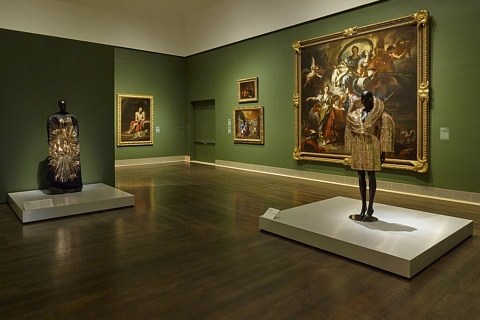The time has come to check in on your whimsical, cottage-core aesthetic, Greek-mythology-obsessed, most likely Queer friends. Hozier has just released another album.
Hozier released his third studio album ‘Unreal Unearth’ on Aug. 18, four years after his last album ‘Wasteland, Baby!.’ Known for how he incorporates works of fiction, myth and history into his lyrics, this new album is no exception for the Irish singer.
With religious imagery, literary comparisons and more, ‘Unreal Unearth’ intertwines inspiration with Hozier’s own experience.
After writing a majority of these songs during the pandemic, Hozier said lines from Dante’s Inferno resonated. In a poem about wandering through Hell in nine circles, Hozier said, “That’s something that I wanted, in particular, to explore in this album — that each Circle is a slightly different voice.”
Let it be known, a lot of this will come with my own interpretation as a listener, so take everything with a grain of salt. Feel free to interpret the art however you please.
De Selby Parts 1 and 2
Along with having one of the best transitions between songs, the two separate parts of De Selby lead the listener to begin their descent into the overall sound of the album.
It has been said Hozier centered the story of De Selby, mainly the second part which had a video starring Domhnall Gleeson, on the Irish novel The Third Policeman. This novel written by Flann O’Brien in 1939, published in 1967, is compared to the work of Kafka.
The character of de Selby is a representation of darkness in many ways. In the two-song explanation, we can see the dark environments, themes and mentality of the character portrayed. This is shown in the lyrics “You take in the blackness of air, the likes of a darkness so deep that God at the start couldn’t bear,” in ‘De Selby (Part 1).’
In the music video for Part 2, the concept of darkness was clear with the black-and-white coloring. I noticed an almost “Groundhog Day” effect of repeating the same moment over and over again to drive someone mad. There is another portion when supposedly De Selby, sees an image of himself and decides to attack and bury him, which drew my mind to the parallels of Cain and Abel.
The parts of De Selby work as an introduction to the nine circles of Hell in Dante’s vision. Hozier described this character as a man who does not know he is dead yet. As a listener, we share the same feeling of anticipating what is to come and trying to navigate the darkness.
In Part 1, Hozier sings portions of the song in Gaelic. He described those verses as a sign of metamorphosis, showing how in the darkness, you can be freed from things outside.
First Time
Possibly my favorite track on the album as of now, I first listened and made comparisons outside of mythology. I pictured this song playing in the background of a film where a couple meets to slow dance for the first time.
In the descent into the nine circles, ‘First Time’ is telling the journey through limbo. This is the first circle of Hell as described in Canto IV of Dante’s Inferno. It is made hold the souls of those who are good but did not reach Heaven. Those who “did not sin, but even their just merits were not enough.”
The whole point of limbo is fluctuation. It is the largest circle and covers the most ground on morality with the souls it contains. In ‘First Time,’ we see versatility and vastness told through a single relationship. How a couple can rise and fall. In the first chorus of the song, “and some part of me came alive, the first time that you called me, “baby”,” and the last verse of the song, “some part of me must have died, the final time that you called me, “baby”,” we see this.
Francesca
Named after a character in Dante’s Divine Comedy, ‘Francesca’ shows the effect of the second circle surrounding lust. In Canto V, Dante calls out to souls to hear their story, and Francesca answers. Her story is one of not loving her arranged husband and earning her spot in the second circle through an affair with her lover.
Francesca is condemned for adultery, but in the song, the lovers are unapologetic for their actions. With the lyrics, “I would still be surprised I could find you, darlin’, in any life. If I could hold you for a minute, darlin’, I would do it again,” and the outro, “I would not change it each time. Heaven is not fit to house a love like you and I,” this shows their love triumphs where they end up. Heaven or Hell.
I, Carrion (Icarian)
Continuing the journey through the second circle, ‘I, Carrion (Icarian)’ follows the tale of death caused by ambition. Some may be familiar with the myth of Icarus and how he flew too close to the sun, but this song shifts the narrative to his relationships.
There are tones of feeling weighed down until someone comes to bring us up, whether that be a family member, a lover or some other support system.
The lyrics describing “feeling lighter” can mean in a theoretical sense, taking the weight off of your shoulders or finding some relief in a partner, or in a more physical sense like when Icarus gets his wings. The story is about trust overall and finding someone to help the worry you carry. The acts of service, sometimes unseen by a partner, we see in the lyrics, “Once I had wondered what was holdin’ up the ground, but I can see that all along, love, it was you all the way down.”
Damage Gets Done (feat. Brandi Carlile)
In the track featuring Brandi Carlile, Hozier explores the fourth circle and greed. The start of this song to me felt linked to the saying, “Money cannot buy happiness.” It explores the perspective of a couple who grow into wealth, and therefore, lost joy.
The way Hozier and Carlile’s voices harmonize, “we knew what our love was worth (when we had nothing),” and “I miss when we did not need much,” really drives this point home for me that sometimes financial burden can be its own circle of Hell.
Son of Nyx
The instrumental track on the album still holds significance to the story without needing lyrics. The background of the song, Hozier said, is dedicated to co-writer Alex Ryan who is a son of ‘Nick.’
The story and the sixth circle blend well with the mythology behind Nyx, the goddess of darkness. Her son, Charon carries the souls across the River Styx and is an active role in the journey to the Underworld.
Butchered Tongue
Hozier goes beyond mythology and into historical relevance in talking about the Irish Rebellion of 1798 and how it links with the seventh circle and violence.
The violence and bloodshed during that time came hand-in-hand with the loss of Irish culture, which makes Hozier singing in said languages throughout the album so important. ‘Butchered Tongue’ as a title stems from the dismemberment of native people’s bodies, but attention is drawn to the tongue by the erasure of native languages.
First Light
The album’s closer represents the ascent from Hell and the end of a journey. This song highlights the feeling of relief and seeing the light at the end of the tunnel.
The last lines of the album being, “like I lived my whole life before the first light (some bright morning comes),” signifies the end and lets the listener recount everything they heard on the way through.
This album has so much more to unpack in every song, but these references and interpretations are what stuck with me the most. As always, Hozier understands love in complex ways that tie the past to the present and the stories to the experiences.





Recent Comments